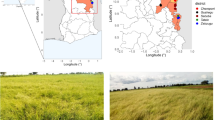Abstract
Investigation of the genetic system of six species ofPlantago has revealed striking differences in their breeding and meiotic systems.Plantago patagonica is an inbreeder on account of preanthesis cleistogamy, whereasP. lanceolata is an obligate outbreeder, as it is self-incompatible.Plantago drummondii, P. lagopus, P. ovata, andP. major show mixed mating but in varying proportions. In terms of their energy budgets, outbreeding species invest more in floral advertisement and male function, while inbreeders invest more in female function. The contribution of the meiotic system to genetic variability, as revealed through recombination index, is more important in the inbreeding species.
Similar content being viewed by others
References
Arroyo, M. T. K. de, 1973: Chiasma frequency evidence on the evolution of autogamy inLimnanthes floccosa (Limnanthaceae). — Evolution27: 679–688.
Badr, A., El-Kholy, M. A., 1987: Chromosomal studies in the Egyptian flora II. Karyotype studies in the genusPlantago L. — Cytologia52: 725–731.
Barrett, S. C. H., Shore, J. S., 1987: Variation and evolution of breeding systems in theTurnera ulmifolia L. complex (Turneraceae). — Evolution41: 340–354.
Bos, M., Haring, E. V. D., 1988: Gene flow inPlantago II. Gene flow patterns and population structure. A simulation study. — Heredity61: 1–11.
—, 1985: Protogyny inPlantago lanceolata populations: an adaptation to pollination by wind. — InJacquard, P., Heim, G., Antonovics, J., (Eds.): Genetic differentiation and dispersal in plants, pp. 327–338. — Berlin, Heidelberg, New York: Springer.
Briggs, B. G., 1980:Plantago multiscapa—a new species from Eremaean Australia and notes onPlantago in western Australia. — Telopea2: 77–81.
Charlesworth, D., Charlesworth, B., 1981: Allocation of resources to male and female function in hermaphrodites. — Biol. J. Linn. Soc.15: 57–74.
Craven, L. A., 1976: A review of the genusPlantago L. in New Guinea. — Contrib. Herb. Aust.13: 1–7.
Cruden, R. W., 1977: Pollen-ovule ratios—a conservative indicator of breeding systems in flowering plants. — Evolution31: 32–46.
Cumaraswamy, A., Bawa, K. S., 1989: Sex allocation and mating systems in pigeonpea,Cajanus cajan (Fabaceae). — Pl. Syst. Evol.168: 59–69.
Darlington, C. D., 1939: The evolution of genetic systems. — Cambridge: Cambridge University Press.
Gibbs, P. E., Milne, C., Carillo, M. V., 1975: Correlation between the breeding system and recombination index in five species ofSenecio. — New Phytol.75: 619–626.
Grant, V., 1952: Cytogenetics of the hybridGilia millaefolia ×G. achilleifolia I. Variation in meiosis and polyploidy rate as affected by nutritional and genetic conditions. — Chromosoma5: 372.
—, 1971: Plant speciation. — New York: Columbia University Press.
Jain, S. K., 1976: The evolution of inbreeding in plants. — Ann. Rev. Ecol. Syst.7: 469–495.
Jones, N., Rees, H., 1966: Chiasma frequencies and potential genetic variability ofLolium populations. — Nature211: 432.
Kannenberg, L. W., Allard, R. W., 1967: Population studies in the predominantly self-pollinated species VIII. Genetic variability in theFestuca microstachys complex. — Evolution21: 227–240.
Koul, A. K., Sharma, P. K., 1986: Cytogenetic studies ofPlantago ovata Forsk. and its wild allies. — InGupta, P. K., Bahl, J. R., (Eds.): Genetics and crop improvement, pp. 359–366. — Meerut: Rastogi & Co.
Lewis, D., 1979: Sexual incompatibility in plants. — London: Edward Arnold.
Lloyd, D. G., 1965: Evolution of self-compatibility and racial differentiation inLeavenworthia (Cruciferae). — Contr. Gray. Herb.195: 3–134.
Ornduff, R., 1969: Reproductive biology in relation to systematics. — Taxon18: 121–133.
Primack, R. B., 1978: Evolutionary aspects of wind pollination in the genusPlantago (Plantaginaceae). — New Phytol.81: 449–458.
Ross, M. D., 1973: Inheritance of self-incompatibility inPlantago lanceolata. — Heredity30: 169–176.
Schoen, D., 1982: The breeding system ofGilia achilleifolia. Variation in floral characteristics and outcrossing rate. — Evolution36: 352–360.
Sharma, N., Koul, P., Koul, A. K., 1990: Reproductive biology ofPlantago L. III. Floral adaptation to wind pollination inPlantago lagopus L. — Proc. Indian Acad. Sci.100: 393–398.
Sharma, P. K., 1984: Cytogenetic studies on some Himalayan species of genusPlantago. — Ph.D. Thesis, Jammu University, Jammu.
—, 1984: Genetic diversity among Plantagos III. Primary trisomy inPlantago lagopus L. — Genetica64: 135–138.
Stebbins, G. L., 1950: Variation and evolution in plants. — Calcutta: Oxford & IBH Publishing Co.
—, 1957: Self-fertilization and population variability in the higher plants. — Amer. Naturalist91: 337–354.
—, 1974: Flowering plants—evolution above the species level. — London: Edward Arnold.
—, 1946: Artificial and natural hybrids in theGramineae, tribeHordeae. I.Elymus. Sitanion andAgropyron. — Amer. J. Bot.33: 338–351.
Sykes, W. R., 1988: Notes on New ZealandPlantago species. — New Zealand J. Bot.26: 321–323.
Van Damme, J. M. M., 1991: A restorer gene in gynodioeciousPlantago coronopus subject to selection in gametophytic and seedling stage. — Heredity66: 19–27.
Vuille, F., 1987: Reproductive biology of the genusDamasonium (Alismataceae). — Pl. Syst. Evol.157: 63–71.
Wolff, K., Friso, B., Van Damme, J. M. M., 1988: Outcrossing rates and male sterility in natural populations ofPlantago coronopus. — Theor. Appl. Genet.76: 190–196.
Wyatt, R., 1984: The evolution of self-pollination in granite outcrop species ofArenaria (Caryophyllaceae). I. Morphological correlates. — Evolution38: 804–816.
Author information
Authors and Affiliations
Rights and permissions
About this article
Cite this article
Sharma, N., Koul, P. & Koul, A.K. Genetic systems of six species ofPlantago (Plantaginaceae). Pl Syst Evol 181, 1–9 (1992). https://doi.org/10.1007/BF00937582
Received:
Revised:
Accepted:
Issue Date:
DOI: https://doi.org/10.1007/BF00937582




